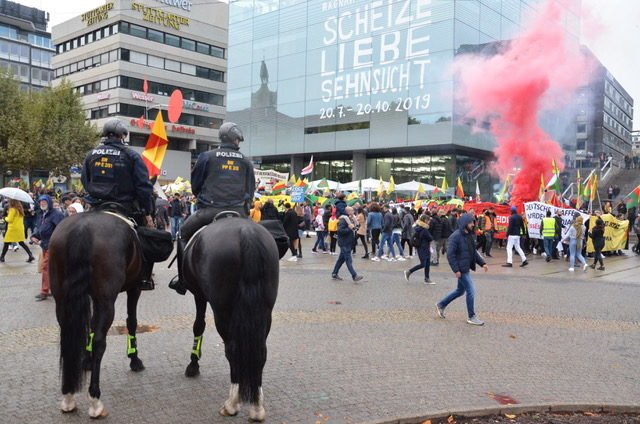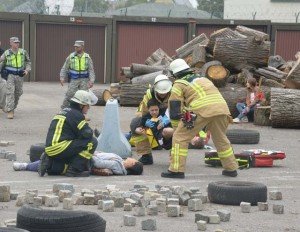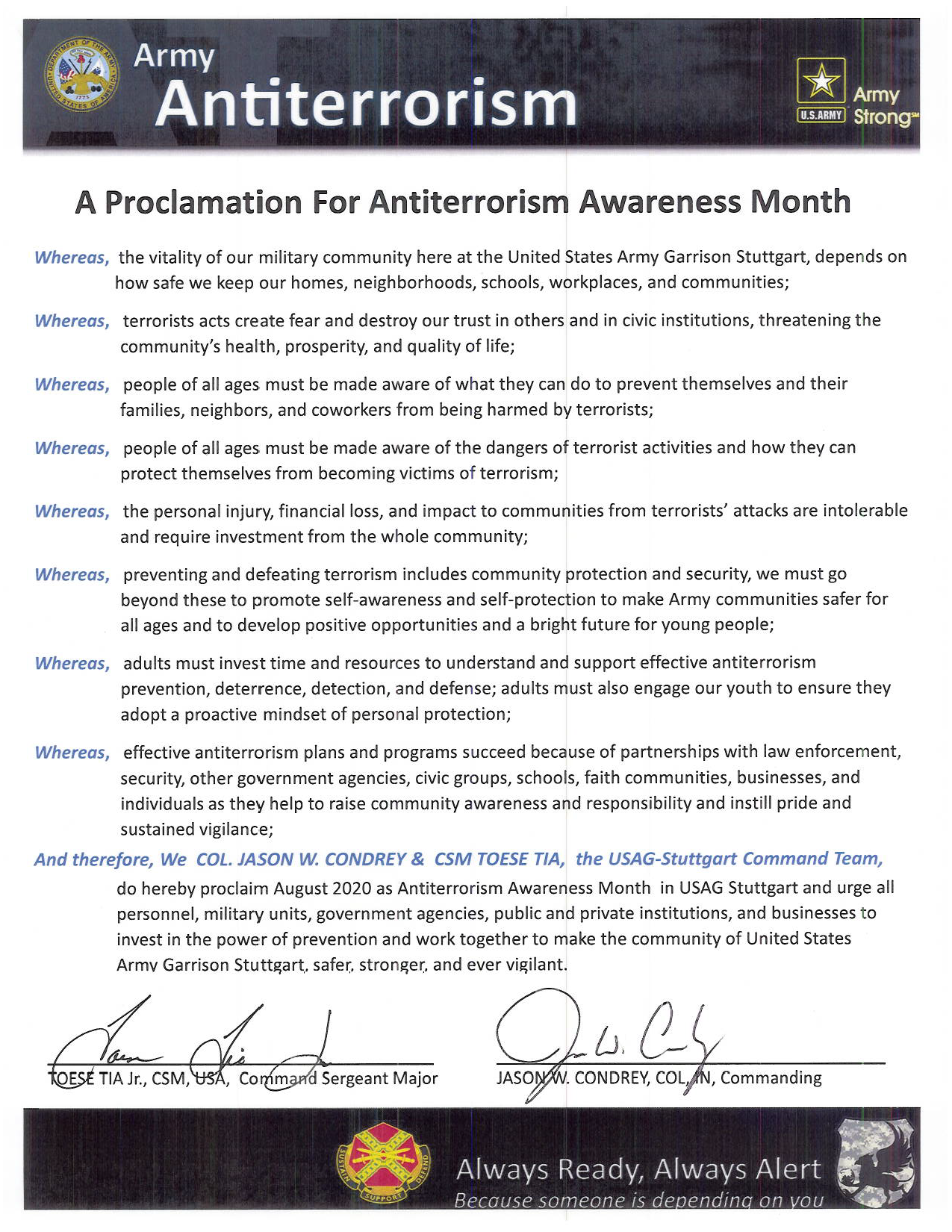
by William Christina
USAG Stuttgart Antiterrorism Officer
August is Antiterrorism Awareness Month. And now, more than ever, your vigilance is required to protect us and our mission.
Amid the COVID-19 pandemic and the resulting civil unrest that has been affecting the global population, we must remember that terrorism continues to be a growing threat, both abroad and at home.
How can we mitigate this? The best protection that we have is you–the “eyes and ears” of our community—utilizing constant vigilance and monitoring daily activities where we live and work.
Always pay attention to your surroundings, and if you observe something suspicious or questionable, report it.
But how do you report it? There are several ways to do so.
First, you can call the Stuttgart Military Police Desk at 07031-15-3102. Off post, dial 110 for German Polizei or 112 for Emergency Services (Ambulance / Fire).
You can also download the free U.S. Army Europe iReport app to your Android or iOS device, or visit ireport.eur.army.mil/. This website allows you to make reports for issues of possible counterterrorism or law enforcement interest (for example, espionage or a hole in a fence, respectively).
The USAG Stuttgart app also has a submission form under the “Emergency” section.
It might be nothing, but it could also be everything and make all the difference.
WHAT IS ANTITERRORISM?
Antiterrorism is essentially, “the defense measures used to reduce the vulnerability of individuals and property to terrorist acts.”
It deals primarily with risk assessment, the establishment of authorized actions to prevent terrorist developments, and various training procedures for preparation of the onset or consequences of a terrorist attack.
As terrorist threats become more internal in nature, the success of a robust antiterrorism campaign depends greatly on the community’s involvement and readiness to identify and report suspicious — and potentially terrorist —behavior and thwart the attack before it occurs.

USAG Stuttgart asks all members of the community, including our Military, DoD personnel, families, and contractors, to strengthen situational awareness, remain informed of changes within USAG Stuttgart and any updates to the antiterrorism standards, and assume an effective level of responsibility for the community’s defense against internal and external terrorist threats.
CONSIDER THE FOLLOWING ACTIVITIES AND BEHAVIOR AS SUSPICIOUS:
- A person or vehicle stays in the same place for an unusual length of time.
- A parked car with the engine running — regardless of a person inside or not.
- A person behaves strangely or exhibits unusual movements, looks out of place or is wandering aimlessly.
- A person concealing an object or carrying a weapon or suspicious bag.
- A person looking into cars, moving from car to car and/or trying to open door handles.
- A person looking into windows of homes or forcibly entering a car or home.
- A person running from a home for no apparent reason, especially at night.
- A vehicle drives around your block frequently, slowing down and speeding up.
- A vehicle without lights on, arriving or leaving at night.
- A person who is asking questions about security forces, security measures or sensitive information.
- A person who is drawing pictures or taking notes in a location that is not normally of interest to a tourist.
- A briefcase, backpack, suitcase or package left unattended.
- Chemical smells or fumes that worry you.
Many activities or behaviors can be considered suspicious, and there could be reasonable explanations for some suspicious-looking activities or behavior. But by thinking things through, being observant and using common sense, you will be able to make a good judgment about whether an activity or behavior is suspicious. Your role as a concerned citizen is to report whatever you think is wrong or suspicious.
WHAT ARE THE TYPES OF TERRORISM?
State-Sponsored terrorism, which consists of terrorist acts on a state or government by a state or government.
Dissent terrorism, which are terrorist groups which have rebelled against their government.
Left- and right-wing terrorists, which are groups rooted in political ideology.
Religious terrorism, which are terrorist groups which are extremely religiously motivated; and
Criminal Terrorism, which are terrorist acts used to aid in crime and criminal profit.
ENTER THE “LONE WOLF”
The most dangerous, unpredictable and random element within the terror arena is the “Lone Wolf.” He or she may be a Local National, a recent immigrant, a disgruntled individual, or perhaps an extremist. He or she might be residing on post, among us; known, liked, and respected, but with an agenda of terror.
We call this the most dangerous of terrorists because he or she is totally unpredictable and random in who, what, when or why they attack. It is most difficult to plan a counter or mitigation strategy for those aforementioned reasons. Situational awareness and observing “warning signs” are the only real effective mitigators in this scenario.
THE ACTIVE SHOOTER
An active shooter incident can occur at any time and at almost any location. He or she is the perpetrator of a type of mass murder marked by rapidity, scale, randomness and often their suicide at the conclusion of the event. To counter, thwart or successfully mitigate an active shooter, one needs to have the proper education.
It is strongly recommended that personnel attend an Active Shooter Course such as A.L.I.C.E. Training or utilize the standard ‘Run, Hide, Fight’ template that is currently taught internationally.
CYBER TERRORISM
Our immediate concern with cyberterrorism are those acts of internet terrorism including deliberate large-scale disruption of computer networks down to the individual workstation or personal computer by means of viruses, worms, phishing and other malicious software. To combat cyberterrorism, education is once again a vital tool. The Cyber Awareness Course is an annual requirement. The link is https://cs.signal.army.mil.
LEARNING MORE
An excellent learning tool is Antiterrorism Level 1 Training, which is mandatory annual training for all U.S. Military and DoD civilian personnel. Though optional for them, dependents (Family Members) and contractor personnel are highly encouraged to take this training as well. AT Level I can easily be accessed through the Joint Knowledge Online portal at https://jkodirect.jten.mil.

CONCLUSION
During the month of August, you will see us out in the community setting up displays and giving out Antiterrorism/Force Protection and other Mission Assurance information. We will be at the Post Exchange (PX), Commissary, bowling alley and other locations, and we’re looking forward to meeting you all—the members of our Stuttgart Military Community. You are our best line of defense as our “eyes and ears” against those who would target our facilities and personnel with terror activities.
In summary, the USAG Stuttgart Protection Program can only be successful with the community’s dedicated support and due diligence in maintaining situational awareness and reporting any and all suspicious activity. Remember, “If You See Something… Say Something!”

